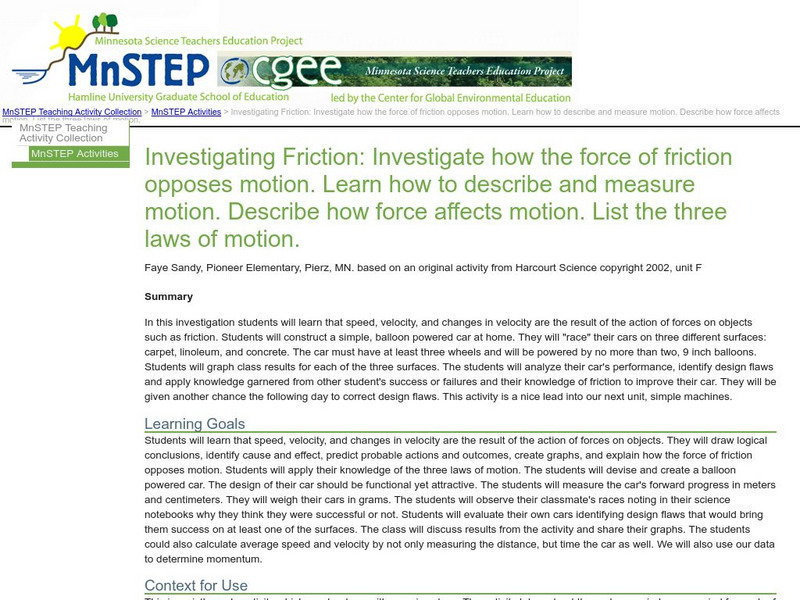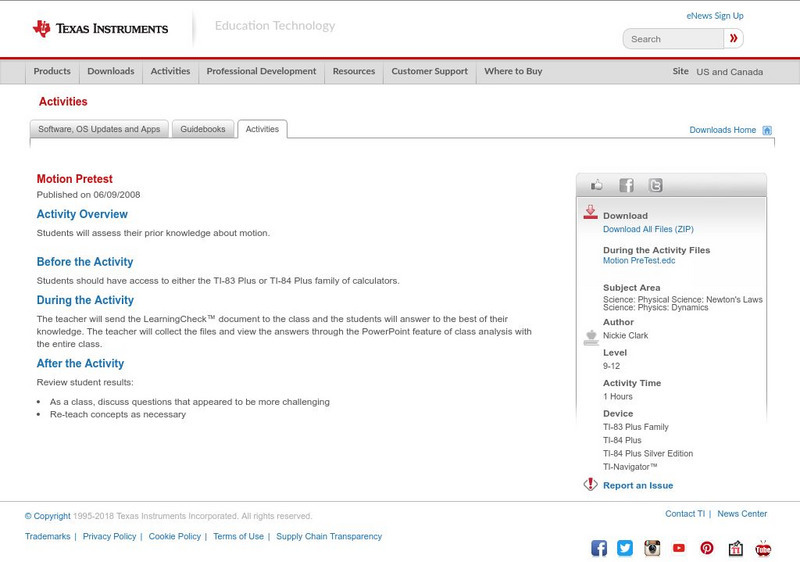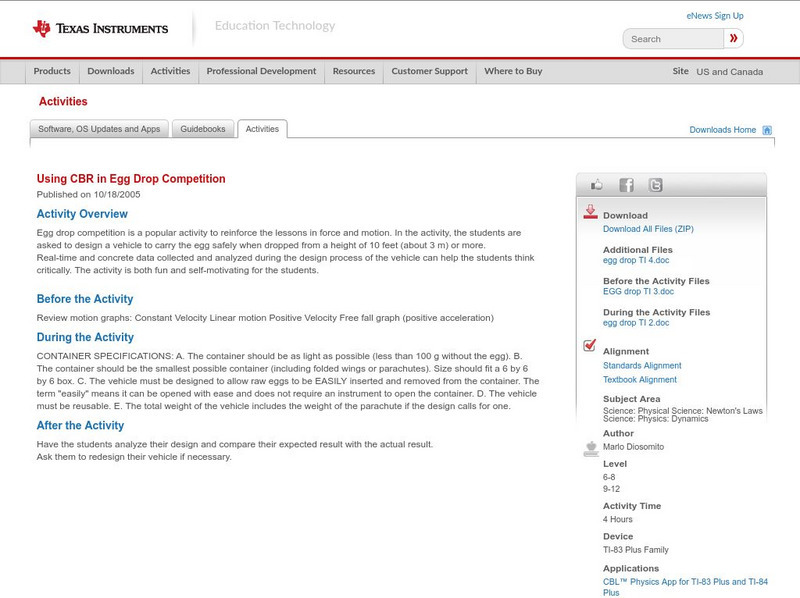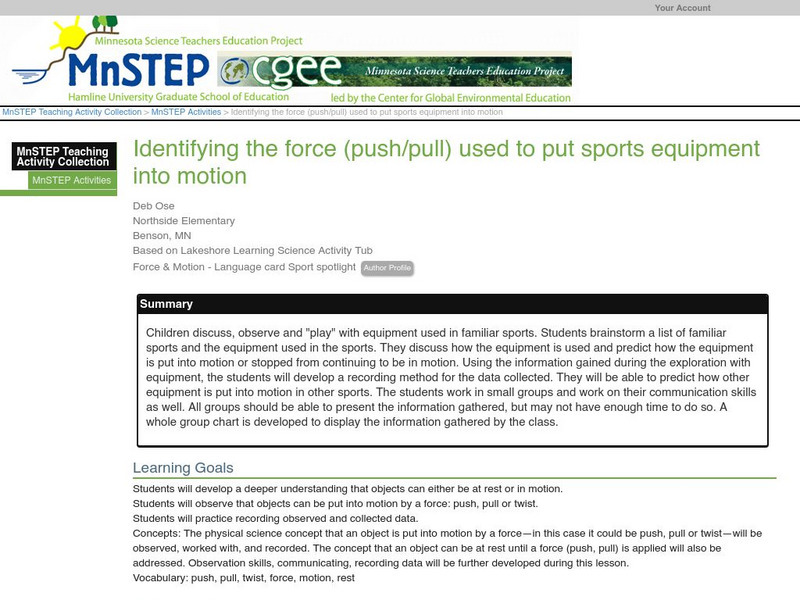Science Education Resource Center at Carleton College
Serc: Investigating Motion Graphing Speed
In this introduction to motion activity, students will get a personal understanding of speed and acceleration by experiencing it firsthand. Wheeled office chairs or other cart like devices are used to give one student a ride as a fellow...
Science Buddies
Science Buddies: Centripetal Force
What keeps you in your seat of a giant loop-de-loop roller coaster? Surprisingly, it is not the seatbelt but the seat. It works because of something called centripetal force and it does much more than make a great roller coaster. In this...
PBS
Pbs Learning Media: Circular Motion
In this interactive activity featuring videos adapted from the Rutgers PAER Group, students will observe examples of circular motion. Students will then find a common reason why the objects and people presented move in a circle. Includes...
Science Education Resource Center at Carleton College
Serc:investigating Friction:investigate How the Force of Friction Opposes Motion
In this investigation, students will learn that speed, velocity, and changes in velocity are the result of the action of forces on objects such as friction. They will be able to explain how the force of friction opposes motion by...
Science Education Resource Center at Carleton College
Serc: Investigating Motion: What Causes Objects to Move?
Students will have an opportunity to determine what makes everyday objects move. Students will be given objects and asked to make predictions on how far each object will move after they blow on it. Then they will measure the distance and...
Texas Instruments
Texas Instruments: Motion Pretest
Students will take a pretest to assess their knowledge about motion in a physical science class.
Science Education Resource Center at Carleton College
Serc: Investigating Motion: Paths of a Marble
In this activity, children will investigate the paths that marbles take once set into motion and then how to change those paths, noting if and how they change.
Texas Instruments
Texas Instruments: Using Cbr in Egg Drop Competition
Egg drop competition is a popular activity to reinforce the lessons in force and motion. In the activity, the students are asked to design a vehicle to carry the egg safely when dropped from a height of 10 feet (about 3 m) or more....
PBS
Pbs Kids: Activities and Videos: Force/energy
Videos that accompany activities that are hands-on challenges that focus on the engineering design process. They use simple materials, allow for multiple solutions, and are ideal for ages 9-12.
TeachEngineering
Teach Engineering: Motion Commotion
Students learn why and how motion occurs and what governs changes in motion, as described by Newton's three laws of motion. They gain hands-on experience with the concepts of forces, changes in motion, and action and reaction. In an...
Utah STEM Foundation
Utah Stem Action Center: Push or Pull?
This super simple activity for kindergarten-age students requires no materials and can be done inside or outside, or both and explores forces and motion.
TeachEngineering
Teach Engineering: Projectile Magic
Students watch video clips from October Sky and Harry Potter and the Sorcerer's Stone to learn about projectile motion. They explore the relationships between displacement, velocity and acceleration and calculate simple projectile...
Concord Consortium
Concord Consortium: Spring and Mass Model
An interactive tool where students can explore how a spring behaves, and how changing the elasticity, mass, push/pull force, and friction affect its motion or period. As the spring moves, its motion is shown on a distance-time graph.
PBS
Pbs Kids: Zoom Printables & Activities
Fantastic variety of printable activities that cover motion-related principles. Topics include the following: experiments (engineering, structures, forces and energy, fluids, sound and light, patterns, human body); arts & crafts;...
TeachEngineering
Teach Engineering: Runaway Train: Investigating Speed With Photo Gates
Students conduct an experiment to determine the relationship between the speed of a wooden toy car at the bottom of an incline and the height at which it is released. They observe how the photogate-based speedometer instrument "clocks"...
Science Education Resource Center at Carleton College
Serc: Newton's Second Law: Constant Force Applied to a Skateboarder
In this lab activity, students will become familiar with Newton's 2nd Law of Motion. By investigating the motion of different skateboarders pulled with a variety of constant force values, they will discover that bodies acted on by a...
Texas Instruments
Texas Instruments: Frictional Forces
In this activity, students' will use a Dual range force sensor to measure the force required to pull a block across different surfaces. They will examine the results to see when more force is needed to move the block and understand the...
Science Education Resource Center at Carleton College
Serc: Identifying the Force Used to Put Sports Equipment Into Motion
Children discuss, observe, and play with equipment used in familiar sports, and then brainstorm a list of familiar sports and the equipment used in the sports. They discuss how the equipment is used, and predict how it is put into motion...
Science Education Resource Center at Carleton College
Serc: Newton's Second: Having a Ball With Motion
Young scholars will create a gravity ball launcher to demonstrate their understanding of mass, force, momentum, and motion. The students will use critical thinking, measurement, and observation and analysis of data to make changes and...
Texas Instruments
Texas Instruments: Graphing Motion
This activity assesses students' knowledge and understanding of graphing motion.
TeachEngineering
Teach Engineering: Ramp and Review (For High School)
In this hands-on activity - rolling a ball down an incline and having it collide into a cup - the concepts of mechanical energy, work and power, momentum, and friction are all demonstrated. During the activity, students take measurements...
Stanford University
Stanford University: Magnetic Force Microscopy
Help students learn how scientists use powerful tools to visualize, study and control materials at the nanoscale.
TeachEngineering
Teach Engineering: Ramp and Review
In this hands-on activity - rolling a ball down an incline and having it collide into a cup - the concepts of mechanical energy, work and power, momentum, and friction are all demonstrated. During the activity, students take measurements...
PBS
Wgbh: Peep and the Big Wide World: Introduce Ramps
An introductory activity where students discover the way things roll and slide down ramps and hills.





















